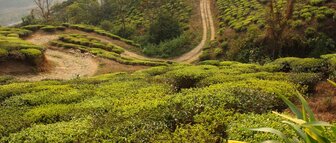Darjeeling - Place where mountains kiss the clouds
Darjeeling is an outcrop at the foothills of the Himalayas in northern India, between Tibet, Nepal and Bhutan. Thanks to the suitable conditions, this tea region has become one of the most famous in the history of tea.
At higher altitudes and lower temperatures, the tea plant grows more slowly, giving it time to accumulate a greater quantity of health-giving and aromatic substances in its leaves.
Are Darjeelings black teas? Yes and no.
Darjeelings are referred to as black teas in terms of processing technology, but they have much more in common with oolongs in terms of the degree of oxidation. An important role in the chosen length of oxidation is played by the substances that the tea plant produces and accumulates at different times during the year.
Depending on the altitude, the first harvests are taken between late February and mid-April. The leaves grow more slowly during this period, which gives them a higher aromatic quality. They are oxidised for a shorter period of time during processing, at around 10-30%, so that their aroma comes out.
Then comes the period called Banji by the Indians, which lasts roughly 3-4 weeks. The tea plant then goes into dormancy and does not produce any leaves as it regenerates.
First Flush or Second Flush?
In the second half of May the plant starts to grow again. The tea plant produces more catechins at this time, which makes the leaves more suitable for longer oxidation. Although the leaves of the Second Flush are larger and tougher than the delicate leaves of the First Flush, they are still full of flavour. They take longer to oxidise during processing, roughly at the 60-80% level. So they are more delicate in taste than teas from Assam, Sikkim or teas from Ceylon (Sri Lanka).
In June comes the monsoon rainy season, which lasts mostly until the end of August. The rains wash away many nutrients from the predominantly sedimentary soil. The autumn harvests (Autumnal Flush) therefore no longer meet our quality criteria. In our experience, even a two-year-old Second Flush is fuller and tastier than an Autumnal Flush.
Why should we care about the quality grade of the tea?
There are two simple reasons for this: taste and quality.
After processing, the tea leaves are sifted through a machine, under which screens with grids of varying fineness are placed. The tea leaves sink lower and lower through the increasingly fine sieves. The topmost sieve is where the best quality tea leaves remain. And through the finest sieve the so-called tea dust "Dust" falls through, which most often goes into the tea bags.
In general, the less broken the tea leaves are, the tastier the tea infusion we get. This is because it is easier to leach the tannins and catechins, which are responsible for the tea's animalistic and bitter taste, from the tiny fragments.
The marking of teas according to quality used in areas that were formerly British colonies:
Exceptional quality class
SFTGFOP - Special Finest Tippy Golden Flowery Orange Pekoe
Highest quality class
FTGFOP - Finest Tippy Golden Flowery Orange Pekoe
Highest quality class for Darjeeling
FTGFOP1 - Finest Tippy Golden Flowery Orange Pekoe 1
Main class in Darjeeling and Assam with the highest proportion of tips
TGFOP - Tippy Golden Flowery Orange Pekoe
Higher proportion of tips than FOP
GFOP - Golden Flowery Orange Pekoe
Whole leaves located higher on the tea plant
FOP - Flowery Orange Pekoe
Whole leaf class consisting of long, wire leaves without tips
OP - Orange Pekoe
Broken Leaves
BOP - Broken Orange Pekoe
Simply put. .. The more letters, the better the tea! :)
